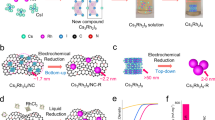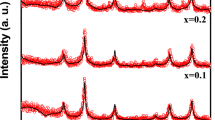Abstract
Spinels can serve as alternative low-cost bifunctional electrocatalysts for oxygen reduction/evolution reactions (ORR/OER), which are the key barriers in various electrochemical devices such as metal–air batteries, fuel cells and electrolysers. However, conventional ceramic synthesis of crystalline spinels requires an elevated temperature, complicated procedures and prolonged heating time, and the resulting product exhibits limited electrocatalytic performance. It has been challenging to develop energy-saving, facile and rapid synthetic methodologies for highly active spinels. In this Article, we report the synthesis of nanocrystalline MxMn3–xO4 (M = divalent metals) spinels under ambient conditions and their electrocatalytic application. We show rapid and selective formation of tetragonal or cubic MxMn3–xO4 from the reduction of amorphous MnO2 in aqueous M2+ solution. The prepared CoxMn3–xO4 nanoparticles manifest considerable catalytic activity towards the ORR/OER as a result of their high surface areas and abundant defects. The newly discovered phase-dependent electrocatalytic ORR/OER characteristics of Co–Mn–O spinels are also interpreted by experiment and first-principle theoretical studies.
This is a preview of subscription content, access via your institution
Access options
Subscribe to this journal
Receive 12 print issues and online access
251,40 € per year
only 20,95 € per issue
Buy this article
- Purchase on SpringerLink
- Instant access to full article PDF
Prices may be subject to local taxes which are calculated during checkout




Similar content being viewed by others
References
Hemberger, J. et al. Relaxtor ferroelectricity and colossal magnetocapacitive coupling in ferromagnetic CdCr2S4 . Nature 434, 364–367 (2005).
Fan, H. J. et al. Monocrystalline spinel nanotube fabrication based on the Kirkendall effect. Nature Mater. 5, 627–631 (2006).
Matsuda, M. et al. Spin-lattice instability to a fractional magnetization state in the spinel HgCr2O4 . Nature Phys. 3, 397–400 (2008).
Bragg, W. H. The structure of magnetite and spinels. Nature 95, 561 (1915).
Shoemaker, D. P., Li, J. & Seshadri, R. Unraverling atomic position in an oxide spinel with two Jahn–Teller ions: local structure investigation of CuMn2O4 . J. Am. Chem. Soc. 131, 11450–11457 (2009).
Thackeray, M. M. Manganese oxides for lithium batteries. Prog. Solid State Chem. 25, 1–71 (1997).
Choi, H. C., Shim, J. H. & Min, B. I. Electronic structures and magnetic properties of spinel ZnMn2O4 under high pressure. Phys. Rev. B 74, 172103 (2006).
Fierro, G. et al. H2 reduction behavior and NO/N2O abatement catalytic activity of manganese based spinels doped with copper, cobalt and iron ions. Catal. Today 116, 38–49 (2006).
Armijo, J. S. The kinetics and mechanism of solid-state spinel formation—a review and critique. Oxid. Met. 1, 171–198 (1969).
Stein, A., Keller, S. W. & Mallouk, T. E. Turning down the heat: design and mechanism in solid-state synthesis. Science 259, 1558–1564 (1993).
Wiley, J. B. & Kaner, R. B. Rapid solid-state precursor synthesis of materials. Science 255, 1093–1097 (1992).
Lavela, P., Tirado, J. L. & Vidal-Abarca, C. Sol–gel preparation of cobalt manganese mixed oxides for their use as electrode materials in lithium cells. Electrochim. Acta 52, 7986–7995 (2007).
Rojas, R. M. et al. Thermal behaviour and reactivity of manganese cobaltites MnxCo3–xO4 (0.0 < x < 1.0) obtained at low temperature. J. Mater. Chem. 4, 1635–1639 (1994).
Matsushita, Y., Ueda, H. & Ueda, Y. Flux crystal growth and thermal stabilities of LiV2O4 . Nature Mater. 4, 845–850 (2005).
Kinoshita, K. Electrochemical Oxygen Technology (Wiley, 1992).
Steele, B. C. H. & Heinzel, A. Materials for fuel-cell technologies. Nature 414, 345–352 (2001).
Lim, B. et al. Pd–Pt bimetallic nanodendrites with high activity for oxygen reduction. Science 324, 1302–1305 (2009).
Greeley J. et al. Alloys of platinum and early transition metals as oxygen reduction electrocatalysts. Nature Chem. 1, 552–556 (2009).
Strasser, P. et al. Lattice-strain control of the activity in dealloyed core–shell fuel cell catalysts. Nature Chem. 2, 454–460 (2010).
Bashyam, R. & Zelenay, P. A class of non-precious metal composite catalysts for fuel cells. Nature 443, 63–66 (2006).
Rios, E., Gautier, J. L., Poillerat, G. & Chartier, P. Mixed valency spinel oxides of transition metals and electrocatalysis: case of the MnxCo3–xO4 system. Electrochim. Acta. 44, 1491–1497 (1998).
Cong, H. N., Abbassi, K. & Chartier, P. Electrocatalysis of oxygen reduction on polypyrrole/mixed valence spinel oxide nanoparticles. J. Electrochem. Soc. 149, A525–A530 (2002).
Ganem, B. & Osby, J. O. Synthetically useful reactions with metal boride and aluminide catalysts. Chem. Rev. 86, 763–780 (1986).
Burns, R. G. The uptake of cobalt into ferromanganese nodules, soils, and synthetic manganese (IV) oxides. Geochim. Cosmochim. Acta 40, 95–102 (1976).
Shubin, M. S., Litinskii, A. O., Popov, G. P. & Men, A. N. Cation-distribution preference energy in crystals formed by binary oxides of transition metals with the spinel structure. J. Struct. Chem. 17, 133–138 (1976).
Burdett, J. K., Price, G. D. & Price, S. L. Role of the crystal-field theory in determining the structures of spinels. J. Am. Chem. Soc. 104, 92–95 (1982).
El-Deab, M. S. & Ohsaka, T. Mangansese oxide nanoparticles electrodeposited on platinum are superior to platinum for oxygen reduction. Angew. Chem. Int. Ed. 45, 5963–5966 (2006).
Chaînet, I. R., Chatenet, M. & Vondrák, J. Carbon-supported manganese oxide nanoparticles as electrocatalysts for the oxygen reduction reaction (ORR) in alkaline medium: physics characterizations and ORR mechanism. J. Phys. Chem. C 111, 1434–1443 (2007).
Yamamoto, K. et al. Size-specific catalytic activity of platinum clusters enhances oxygen reduction reactions. Nature Chem. 1, 397–402 (2009).
Roche, I., Chaînet, E., Chatenet, M. & Vondrák, J. Durability of carbon-supported manganese oxide nanoparticles for the oxygen reduction reaction (ORR) in alkaline medium. J. Appl. Electrochem. 38, 1195–1201 (2008).
Stamenkovic, V. et al. Trends in electrocatalysis on extended and nanoscale Pt-bimetallic alloy surfaces. Nature Mater. 6, 241–247 (2007).
Cheng, F. Y. et al. MnO2-based nanostructures as catalyst for electrochemical oxygen reduction in alkaline media. Chem. Mater. 22, 898–905 (2010).
Ríos, E. et al. Electrocatalysis of oxygen reduction on CuxMn3–xO4 (1 ≤ x ≤ 1.4) spinel particles/polypyrrole composite electrodes. Int. J. Hydrogen Energy 33, 4945–4954 (2008).
Izumi, F. & Ikeda, T. A rietveld-analysis program RIETAN-98 and its application to zeolites. Mater. Sci. Forum 321–324, 198–203 (2000).
Cheng, F. Y. et al. Selective synthesis of manganese oxide nanostructures for electrocatalytic oxygen reduction. ACS Appl. Phys. Interf. 1, 460–466 (2009).
Acknowledgements
This work was supported by the Programs of National NSFC (20873071), MOST (2011CB935902), MOE Innovation Team (IRT0927), Tianjin High-Tech (08JCZDJC21300) and the Fundamental Research Funds for the Central Universities.
Author information
Authors and Affiliations
Contributions
F.C., J.S. and Y.P. synthesized and characterized the materials. F.C. and J.S. carried out electrochemical measurements. B.P. performed the first-principles simulation. All authors contributed to the data analysis. J.C. directed the research.
Corresponding author
Ethics declarations
Competing interests
The authors declare no competing financial interests.
Supplementary information
Supplementary information
Supplementary information (PDF 3871 kb)
Rights and permissions
About this article
Cite this article
Cheng, F., Shen, J., Peng, B. et al. Rapid room-temperature synthesis of nanocrystalline spinels as oxygen reduction and evolution electrocatalysts. Nature Chem 3, 79–84 (2011). https://doi.org/10.1038/nchem.931
Received:
Accepted:
Published:
Issue Date:
DOI: https://doi.org/10.1038/nchem.931
This article is cited by
-
Nanoarchitectonics of cathode electrocatalyst based on CoMn2O4 and graphene nanocomposite for fuel cell applications
Applied Nanoscience (2023)
-
Defect spinel oxides for electrocatalytic reduction reactions
Nano Research (2023)
-
La0.75Sr0.25MnO3-based perovskite oxides as efficient and durable bifunctional oxygen electrocatalysts in rechargeable Zn-air batteries
Science China Materials (2023)
-
Modulating the strong metal-support interaction of single-atom catalysts via vicinal structure decoration
Nature Communications (2022)
-
Cobalt-based oxygen electrocatalysts for zinc-air batteries: Recent progress, challenges, and perspectives
Nano Research (2022)



